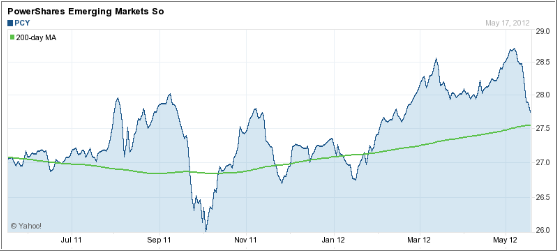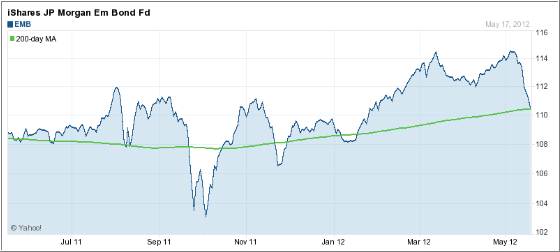 As global economies continue to stutter with little growth expected from the developed European nations, the emerging markets are expected to drive global growth in the decades to come. Emerging markets currently contribute 30 percent of global GDP which will only grow in the future.
As global economies continue to stutter with little growth expected from the developed European nations, the emerging markets are expected to drive global growth in the decades to come. Emerging markets currently contribute 30 percent of global GDP which will only grow in the future.
Emerging market bonds are perceived as riskier, which is rewarded by higher returns. However, many emerging markets have improved their fiscal health and their budget deficits are in fact lower than many developed countries, which indicate lower risk. Also inflation risk has diminished greatly for most countries.
The following two ETFs have a diversified portfolio and can be considered by investors with a little more aggressive streak, which to me is a requirement when seeking exposure in the emerging market fixed income area:
Invesco PowerShares Emerging Markets Sovereign Debt Portfolio (PCY)
PCY follows the DB Emerging Market USD Liquid Balanced Index, which tracks the potential returns of a theoretical portfolio of liquid emerging markets U.S. dollar-denominated government bonds issued by approximately 22 emerging-market countries.
The top holdings include Turkey, Lithuania, South Korea, Peru, Qatar, Colombia, Pakistan, Panama and Vietnam. The fund has returned 43.01 percent over the past three years. Majority of the instruments are rated BBB and BB (73.43 percent) while 13.14 percent is rated B. No bonds in the portfolio are rated below B.
The fund invests 98.1 percent of its assets in government bonds while the remaining 1.9 percent is invested in corporate bonds and cash & equivalents. The fund manages $1.79 billion in assets and has an expense ratio of 50 basis points. PCY, however, has a higher duration and is more vulnerable to interest rate changes. The greater interest rate risk is compensated through higher yields.
Looking at a chart, you’ll notice that PCY is at a crossroads as upward momentum has waned, and this ETF can easily slip to the bearish side of the trend line as the chart below shows:
iShares J.P. Morgan Emerging Markets Bond Fund (EMB)
EMB follows the JPMorgan EMBI Global Core Index which tracks the total return of actively traded fixed-income securities of emerging markets.
The index consists of both floating and fixed rate instruments issued by sovereign or quasi-sovereign entities (backed by 100 percent government guarantee). EMB seeks to invest in issues that have a current outstanding face value exceeding $1 billion and denominated in USD.
This ETF is more diversified than PCY and holds debt securities from 39 countries. Top ten holdings include the Philippines, Russia, Peru, Brazil, Indonesia, Turkey, Uruguay and Mexico. However at 13.55 percent, the corporate bond holding is much higher than PCY.
EMB also holds significant amount of unrated bonds (16.48 percent) while majority of the instruments have ratings between BBB and B (about 76 percent). The fund manages about $4.66 billion in assets and has an expense ratio of 60 basis points. The fund has returned 37.10 percent over the past three years.
While the fundamentals sound great, the chart tells a slightly different story:
EMB has come sharply off its high and is about to cross its long-term trend line to the downside. If you want to seek exposure, make sure the trend is in your favor by moving back up before making a commitment.
For both ETFs, I recommend a 5% trailing sell stop discipline.
Disclosure: No holdings. Charts courtesy of YahooFinance.
Contact Ulli

